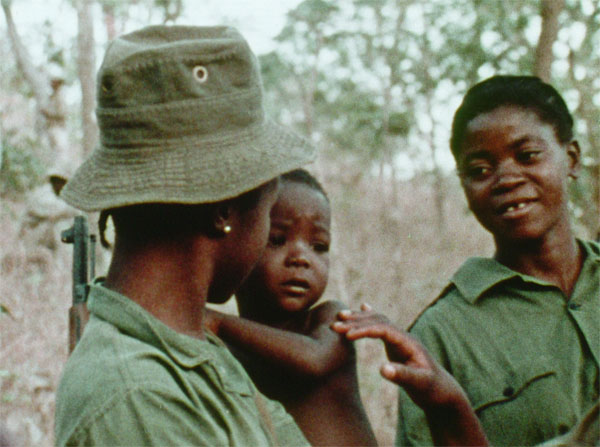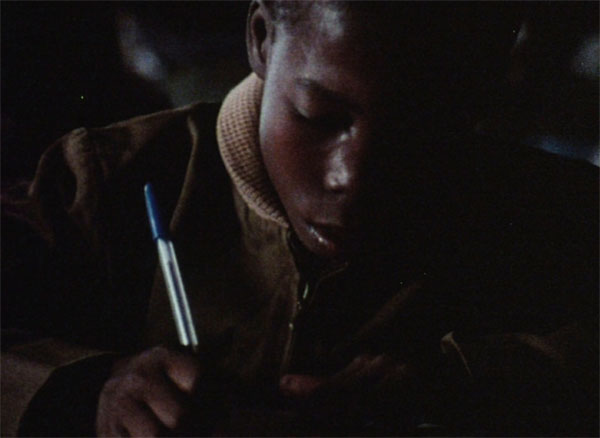In 2011, The Black Power Mixtape 1967-1975 delivered exactly what its title promises, a collage of what was then recently rediscovered footage shot by Swedish journalists who’d come to the States to document an incendiary movement. Street scenes with an undeniable retro chic appeal bridged fascinating clips from interviews with the likes of, most memorably, Angela Davis and Stokely Carmichael. As a whole, Mixtape amounted to nothing more but also most certainly nothing less than what it claimed to be, a scrapbook of glimpses into a vital historical moment.
The title of Göran Hugo Olsson’s followup, Concerning Violence, which premiered at Sundance and will screen in the Panorama Dokumente section of the Berlinale, suggests that an editorial voice is going to be heard a little more clearly than in Mixtape, that an argument’s going to be laid out—even if the subtitle walks it back a bit: Nine Scenes From the Anti-Imperialistic Self-Defense. And an argument is made, but it doesn’t concern violence. The one statement made with clarity comes toward the end and is aimed at developing countries: Don’t try to emulate the first world; forge your own path.
Of course, every one of the film’s 85 minutes addresses violence, but I, for one, am left a little fuzzy as to what it all adds up to, even though the overall structure of Concerning Violence is clearly intended to be more cohesive than that of Mixtape. Over the nine disparate scenes shot in Africa by, once again, Swedish journalists, this time around from the mid-70s to the early 90s—a ferocious raid pulled off by the People’s Movement for the Liberation of Angola, interviews with guerrillas of the Mozambique Liberation Front and other revolutionaries, stark and horrific portraits of the wounded, an infuriating chat with white European Christian missionaries—ex-Fugees vocalist Lauryn Hill reads passages from Frantz Fanon’s landmark book The Wretched of the Earth (1961).
In the reviews that have come out of Sundance, I haven’t seen any mention of the preface, which is odd because I find it to be the most lucid aspect of Concerning Violence. (Perhaps it’s been added since the Sundance premiere?) The only contemporary component of the film, it’s a single shot, lasting several minutes, of Gayatri Chakravorty Spivak, a professor at Columbia, where she’s a founding member of the Institute for Comparative Literature and Society, in (presumably) her office reading a two-page paper that amounts to an appreciation of the work we’re about to see and a biographical sketch of Fanon focusing on the ways in which he was persecuted and misunderstood.
Now, it could be just me, but even here, in the one scene that addresses Fanon’s work in the most explicit form imaginable, the issue of Fanon’s advocacy of the use of violence as a means of achieving what he deemed to be the ultimate goal—decolonization of both the colonized and the colonizers—seems to be skirted. Mentioned, yes—within the context of Fanon’s argument that human beings not treated as such are not bound to the otherwise universal values of humanity—but not dealt with head on as a challenge in the mid-20th century and, of course, right now. That’s what makes Concerning Violence, to this viewer, fascinating but ultimately frustrating as an essay.
WHAT OTHERS ARE SAYING
“Recalling such revolutionary montage-makers as Sergei Eisenstein, Fernando Solanas and Santiago Alvarez, Concerning Violence operates like a clarion call from the past that resonates in the present,” writes Anthony Kaufman at Sundance Now. “It also stands out as a refreshing antidote to the conventionally made social issue docs.”
“Will it help to be boned up on your ’60s and ’70s historical hotspots?” asks Time Out‘s Joshua Rothkopf. “Undoubtedly: Concerning Violence demands a plugged-in viewer, as does Chris Marker‘s immortal history of the left wing, A Grin Without a Cat (1977), to which this project feels like an addendum…. Finding purchase here will be valuable, especially when the takeaway is less a didactic sense of outrage than a more measured examination of the sacrifices people make to bring about change.”
“It’s a tough and cerebral but finally illuminating film,” finds Boyd van Hoeij in the Hollywood Reporter. “What was and wasn’t available in the archives obviously played a large role, though the mosaic structure of the film, together with the superstructure provided by the quotes from Fanon, a Martinique-born, Algerian-French psychiatrist and philosopher, ensures that a big picture does emerge, even if it’s not the most nuanced (quotes lack the larger context of the book and context for the specific scenes shown is also lacking).”
“The book’s polemical attitude as it comes up throughout the film portrays colonialism in fully abstract terms, making the precise focus of the movie less relevant than its overall outlook,” writes Indiewire‘s Eric Kohn. “One of the great filmmakers to investigate African colonialism, Jean Rouch, did so with highly inventive documentary-fiction hybrids that told the story of colonialist oppression through embellished stories constructed by its native stars. Concerning Violence contains a similar degree of sophistication by repurposing material crafted for journalistic purposes into a grander artistic statement on the roots of civil unrest.”
For the Playlist‘s Kevin Jagernauth, “while the film does provide some (usually scant) background as it jumps from country to country, there are times when you wish there was just a little more information provided to set up the next stop in the film’s continental journey.”
When he was still editing Film.com, David Ehrlich interviewed Olsson.
Update, 2/23: “My friend and colleague Brandon Harris has written about the film in more detail as part of this magazine’s Sundance 2014 coverage,” notes Ashley Clark for Filmmaker, “and I can only echo his enthusiasm. It’s a ferocious, consistently stimulating work rife with contemporary geopolitical relevance. I was on hand to capture the highlights of Olsson’s post-screening Q&A session.”
Sundance 2014 Index. For news and tips throughout the day every day, follow @KeyframeDaily on Twitter and/or the RSS feed. Get Keyframe Daily in your inbox by signing in at fandor.com/daily.





